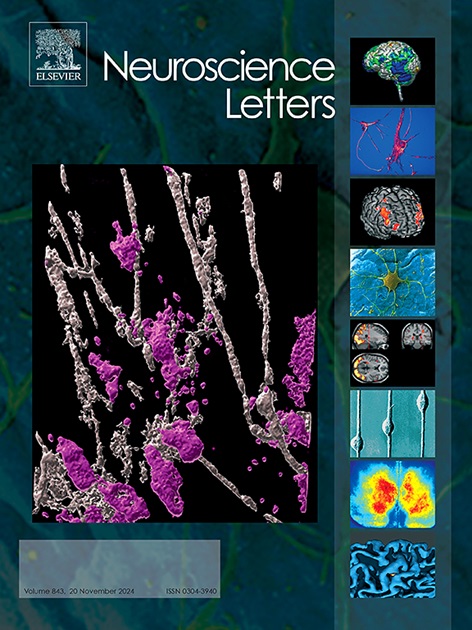游离脂肪酸受体激动剂AS2034178 (bis{2-[(4-{(4'-(2-羟基乙氧基)-2'-甲基[1,1'-联苯]-3-基)甲氧基}苯基]甲基]-3,5-二氧基-1,2,4-恶二唑烷-4-ide}四水合物)有效抑制INa和IK(DR)的证据。
IF 2.5
4区 医学
Q3 NEUROSCIENCES
引用次数: 0
摘要
AS2034178 是游离脂肪酸受体-1 或 G 蛋白偶联受体 40 的激动剂,能增强胰腺 β 细胞的功能。我们研究了它对可兴奋细胞,尤其是垂体瘤(GH3)细胞中离子电流的影响。AS2034178 抑制了电压门控 Na+ 电流(INa)的瞬时(INa(T))和晚期(INa(L))成分,IC50 值分别为 29.8 µM 和 5.3 µM。它不会改变电流-电压关系,但会使 INa(T)的稳态失活曲线左移。AS2034178 还能阻断由持久斜坡电压激活的持续 Na+ 电流(INa(P)),随后施用溴氰菊酯或氟氯氰菊酯能减弱其抑制作用。这些化合物延长了 INa(P)失活的恢复时间,移动了其失活曲线,并缩短了 IN(P)衰减的时间常数。此外,AS2034178 还抑制了延迟整流 K+ 电流(IK(DR)),其解离常数为 6.23 µM。对接研究表明,AS2034178 能够与 hNaV1.7 通道中的氨基酸残基相互作用(补充数据)。AS2034178 对离子电流(INa 和 IK(DR))的影响有助于其在培养或体内的作用机制。本文章由计算机程序翻译,如有差异,请以英文原文为准。
Evidence for effective suppression of INa and IK(DR) by AS2034178 (bis{2-[(4-{(4′-(2-hydroxyethoxy)-2′-methyl[1,1′-biphenyl]-3-yl)methoxy}phenyl]methyl]-3,5-dioxo-1,2,4-oxadiazolidin-4-ide} tetrahydrate), an agonist of free fatty acid receptor
AS2034178, an agonist of free fatty acid receptor-1 or G protein-coupled receptor 40, enhances pancreatic β-cell function. Its impact on ionic currents in excitable cells, particularly pituitary tumor (GH3) cells, was investigated. AS2034178 suppressed transient (INa(T)) and late (INa(L)) components of voltage-gated Na+ current (INa) with IC50 values of 29.8 and 5.3 µM, respectively. It did not alter current–voltage relationship but shifted steady-state inactivation curve of INa(T) leftward. AS2034178 also blocked persistent Na+ current (INa(P)) activated by long-lasting ramp voltages, and subsequent application of deltamethrin or tefluthrin attenuated its suppression. The compound prolonged recovery of INa(P) inactivation, shifted its inactivation curve, and shortened time constant for IN(P) decay. Additionally, AS2034178 suppressed delayed-rectifier K+ current (IK(DR)) with a dissociation constant of 6.23 µM. Docking studies suggested AS2034178′s ability to interact with amino acid residues in hNaV1.7 channels.(supplementary data). AS2034178′s effects on ionic currents (INa and IK(DR)) contribute to its mechanisms of action in culture or in vivo.
求助全文
通过发布文献求助,成功后即可免费获取论文全文。
去求助
来源期刊

Neuroscience Letters
医学-神经科学
CiteScore
5.20
自引率
0.00%
发文量
408
审稿时长
50 days
期刊介绍:
Neuroscience Letters is devoted to the rapid publication of short, high-quality papers of interest to the broad community of neuroscientists. Only papers which will make a significant addition to the literature in the field will be published. Papers in all areas of neuroscience - molecular, cellular, developmental, systems, behavioral and cognitive, as well as computational - will be considered for publication. Submission of laboratory investigations that shed light on disease mechanisms is encouraged. Special Issues, edited by Guest Editors to cover new and rapidly-moving areas, will include invited mini-reviews. Occasional mini-reviews in especially timely areas will be considered for publication, without invitation, outside of Special Issues; these un-solicited mini-reviews can be submitted without invitation but must be of very high quality. Clinical studies will also be published if they provide new information about organization or actions of the nervous system, or provide new insights into the neurobiology of disease. NSL does not publish case reports.
 求助内容:
求助内容: 应助结果提醒方式:
应助结果提醒方式:


